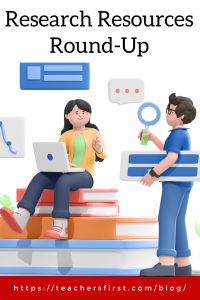The Internet changed forever in 1998 when Larry Page and Sergey Brin created Google. After a quick Google search, you’ll learn that Google was founded on September 4, 1998. However, Google changed its celebration date to September 27 in 2006 to coincide with the announcement of the record number of pages that the search engine was indexing.
Before Google became synonymous with searching on the Internet, Yahoo and Dogpile were two of the most used search engines. Today, the Internet provides more information than ever at our fingertips, making research skills critical for student success. Students must develop research skills and strategies to access information, evaluate it for accuracy, and use it. The research process is a vital part of learning, and below are strategies you can use to teach these skills to your students.
Research Skills and Resources
TeachersFirst has a collection of free research tools vetted by teachers.
Search Engines
Google is the most popular search engine, but there are other ways to search online. This OK2Ask webinar recording shares how Microsoft’s Edge browser can enhance instruction. One quick search engine tip is to encourage students to use quotation marks when searching to indicate the entire phrase. Quotations ensure the most relevant pages appear at the top of the search results.
Organizing Information
The TeachersFirst website has a collection of free organizational tools for helping students to organize their research. One strategy is to make concept maps to organize information using bubbl.us (reviewed here). In addition, Wakelet (reviewed here) is a fantastic tool for students to organize and curate resources during the research process.
Evaluating Information
Research shows students need to learn the difference between news, advertisements, and disinformation. Fake News (reviewed here) shares suggestions on how to avoid disinformation. In addition, secondary students can understand how and why fake news is created and distributed with the game Fake It to Make It (reviewed here).
Citing Information
Students must be taught to give credit where credit is due. Even pieces created using Creative Commons licensing often require attribution. There are many ways to introduce students to citing sources. For example, EasyBib (reviewed here), a free citation generator, assists students with creating and organizing a works cited page.
Research skills help students prepare to enter the workplace. Additionally, learning the research process is a key component of student intellectual growth. What are your favorite strategies and resources for research in the classroom? We’d love to hear about them in the comments below!


